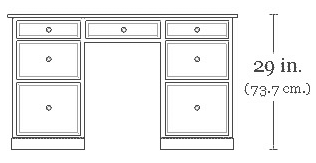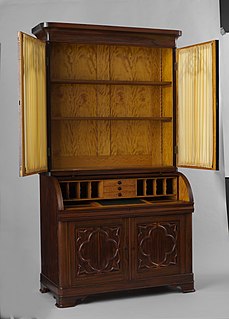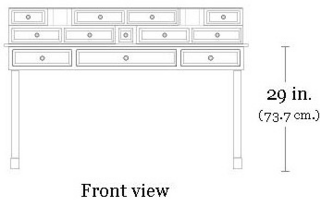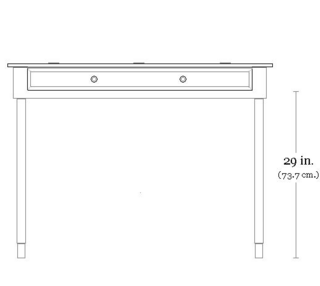This article possibly contains original research .(January 2017) |

A desk is a piece of furniture intended for writing on, hence writing desk is redundant. It is usually found in an office or study.
This article possibly contains original research .(January 2017) |

A desk is a piece of furniture intended for writing on, hence writing desk is redundant. It is usually found in an office or study.
Traditionally, a desk was meant for writing by hand letters but it has adapted to accommodate first typewriters and now computers. Some variations, like the bureau have a top that closes to hide current work, which makes the room containing it look tidy, maintains privacy, and protects the work. The closing top may take the form of a drum that is rolled closed, while others fold closed. The writing surface (or place for lap-top) typically folds down (when also being the lid) or slides out, to preserve the compact size when closed. They usually have bigger drawers below the writing surface and small drawers or "pigeon holes" inside the closing part.
Modern writing desks are designed for laptop computers of the 21st century. They are typically too small for most desktop computers or a printer.

A notebook is a book or stack of paper pages that are often ruled and used for purposes such as note-taking, journaling or other writing, drawing, or scrapbooking.

An armoire desk is a writing-table built within a large cabinet, usually 1.5–2.0 metres high. The cabinet is closed by two to four full-height doors, to keep out dust or to give a tidy appearance to a room by hiding the cluttered working surface of the desk. This form of desk is usually placed against a wall, like its antique uncle, the secretary desk.

A desk or bureau is a piece of furniture with a flat table-style work surface used in a school, office, home or the like for academic, professional or domestic activities such as reading, writing, or using equipment such as a computer. Desks often have one or more drawers, compartments, or pigeonholes to store items such as office supplies and papers. Desks are usually made of wood or metal, although materials such as glass are sometimes seen.

A pedestal desk or a tanker desk is usually a large, flat, free-standing desk made of a simple rectangular working surface resting on two pedestals or small cabinets of stacked drawers of one or two sizes, with plinths around the bases. Often, there is also a central large drawer above the legs and knees of the user. Sometimes, especially in the 19th century and modern examples, a "modesty panel" is placed in front, between the pedestals, to hide the legs and knees of the user from anyone else sitting or standing in front. This variation is sometimes called a "panel desk". The smaller and older pedestal desks with such a panel are sometimes called kneehole desks, and were usually placed against a wall.

In computing, the desktop metaphor is an interface metaphor which is a set of unifying concepts used by graphical user interfaces to help users interact more easily with the computer. The desktop metaphor treats the computer monitor as if it is the top of the user's desk, upon which objects such as documents and folders of documents can be placed. A document can be opened into a window, which represents a paper copy of the document placed on the desktop. Small applications called desk accessories are also available, such as a desk calculator or notepad, etc.

A secretary desk or escritoire is made of a base of wide drawers topped by a desk with a hinged desktop surface, which is in turn topped by a bookcase usually closed with a pair of doors, often made of glass. The whole is usually a single, tall and heavy piece of furniture.

A writing table has a series of drawers directly under the surface of the table, to contain writing implements, so that it may serve as a desk. Antique versions have the usual divisions for the inkwell, the blotter and the sand or powder tray in one of the drawers, and a surface covered with leather or some other material less hostile to the quill or the fountain pen than simple hard wood.
The Wooton desk is a variation of the fall front desk.

An office is a space where an organization's employees perform administrative work in order to support and realize objects and goals of the organization. The word "office" may also denote a position within an organization with specific duties attached to it ; the latter is in fact an earlier usage, office as place originally referring to the location of one's duty. When used as an adjective, the term "office" may refer to business-related tasks. In law, a company or organization has offices in any place where it has an official presence, even if that presence consists of a storage silo rather than an establishment with desk-and-chair. An office is also an architectural and design phenomenon: ranging from a small office such as a bench in the corner of a small business of extremely small size, through entire floors of buildings, up to and including massive buildings dedicated entirely to one company. In modern terms an office is usually the location where white-collar workers carry out their functions. According to James Stephenson, "Office is that part of business enterprise which is devoted to the direction and co-ordination of its various activities."

There are two kinds of trestle desk: as with trestle tables, some have trestles joined by one or more stretchers, and some have free-standing trestles. They can be dismantled, with the desk top removed from the trestles, for storage or transport.

A bureau à gradin is an antique desk form resembling a writing table with, in addition, one or several tiers of small drawers and pigeonholes built on part of the desktop surface. Usually the drawers and pigeonholes directly face the user, but they can also surround three sides of the desk, as is the case for the Carlton house desk form. A small, portable version is a bonheur du jour.

A tambour desk is a desk with desktop-based drawers and pigeonholes, in a way resembling bureau à gradin. The small drawers and nooks are covered, when required, by reeded or slatted shutters, tambours, which usually retract in the two sides, left and right. It is a flatter and "sideways" version of the rolltop desk.

In cabinetry, the bargueño is a form of portable desk, made up of two chests, the bottom one usually having drawers and the top one having a hinged desk surface which also serves as a side-mounted lid. It is basically a chest or box with one of the side panels, rather than the top panel, serving as a fold-out writing surface. The interior of the desk is equipped with small drawers, pigeonholes, etc., for storing papers and supplies. The bargueño has also been used for sewing or as a jewel chest.

A spinet desk is an antique desk with an exterior shape similar to a writing table, But slightly higher and is fitted with a single drawer under the whole length of the flat top surface. The spinet desk is so named because when closed it resembles a spinet, a musical instrument of the harpsichord family.

A credenza desk is a modern desk form usually placed next to a wall as a secondary work surface to that of another desk, such as a pedestal desk, in a typical executive office. When used as an active work surface, the credenza desk is often placed against the wall immediately behind or perpendicular to the main desk, but close enough that the user can reach it from the seated position at the main desk by simply swivelling and wheeling their office chair over to it. It would typically be used for extra storage as well as an open work surface for paperwork, filing, or other tasks taking up more room than would be practical at the main desk.

A filing cabinet is a piece of office furniture for storing paper documents in file folders. In the most simple context, it is an enclosure for drawers in which items are stored. The two most common forms of filing cabinets are vertical files and lateral files. A vertical file cabinet has drawers that extend from the short side of the cabinet. A lateral file cabinet has drawers that extend from the long side of the cabinet. These are also called side filers in Great Britain. There are also shelf files, which go on shelves. In the United States, file cabinets are usually built to accommodate 8.5 × 11 paper, and in other countries, filing cabinets are often designed to hold other sizes of paper, such as A4 paper.

A table is an item of furniture with a raised flat top and is supported most commonly by 1 or 4 legs, used as a surface for working at, eating from or on which to place things. Some common types of table are the dining room table, which is used for seated persons to eat meals; the coffee table, which is a low table used in living rooms to display items or serve refreshments; and the bedside table, which is commonly used to place an alarm clock and a lamp. There are also a range of specialized types of tables, such as drafting tables, used for doing architectural drawings, and sewing tables.

A toolbox is a box to organize, carry, and protect the owner's tools. They could be used for trade, a hobby or DIY, and their contents vary with the craft.

A folding table is a type of folding furniture, a table with legs that fold up against the table top. This is intended to make storage more convenient and to make the table more portable. Many folding tables are made of lightweight materials to further increase portability.

Louis XVI furniture is characterized by elegance and neoclassicism, a return to ancient Greek and Roman models. Much of it was designed and made for Queen Marie Antoinette for the new apartments she created in the Palace of Versailles, Palace of Fontainebleau, the Tuileries Palace, and other royal residences. The finest craftsmen of the time, including Jean-Henri Riesener, Georges Jacob, Martin Carlin, and Jean-François Leleu, were engaged to design and make her furniture.